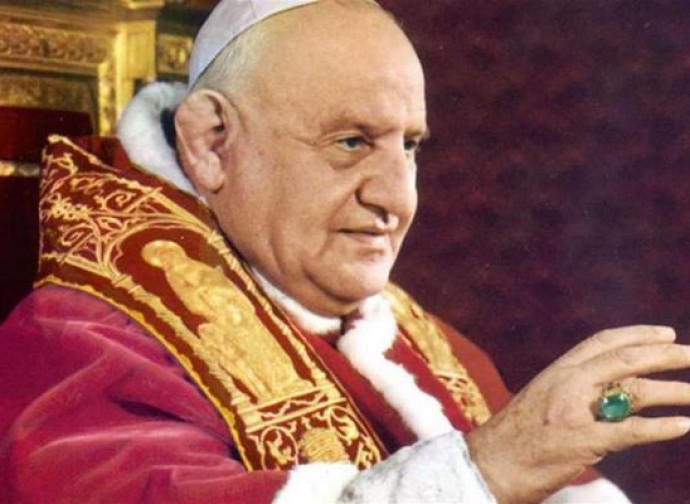Saint John XXIII
He grew up with great devotion to the Blessed Virgin, also thanks to his closeness to the Shrine of Our Lady of the Woods, which he called “the smile of my childhood, the safekeeping and encouragement of my priestly vocation”.

Before he was elected to the Petrine throne and earned the affectionate moniker of “the Good Pope”, St John XXIII (1881-1963) had already manifested many of what would be the features of his pontificate. Giuseppe Angelo Roncalli, fourth of thirteen children of a peasant family, was born in Sotto il Monte (Bergamo). He grew up with great devotion to the Blessed Virgin, also thanks to his closeness to the Shrine of Our Lady of the Woods, which he called “the smile of my childhood, the safekeeping and encouragement of my priestly vocation”.
He was military chaplain during the First World War and today is the patron saint of the Italian Army (despite some controversy from those who confuse peace with pacifism). In the ‘20s and ‘40s he showed his diplomatic skills in apostolic missions in Bulgaria, Turkey and France. In Istanbul and Paris, as did Pius XII in the Vatican, he worked to save the Jews from deportation, providing them with false documents, medicines, and food, and urging the help of kings and ambassadors. As Patriarch of Venice he revealed all his spontaneity in his relations with the people combined with pastoral zeal, which induced him to put the sacrament of Confession at the centre of his endeavour: “Anyone can need to confess and I could not refuse the confidences of a soul in distress”. At that same time he defined progressive democracy, imperialism, secularism, Marxism and Freemasonry as “the five wounds of the Crucifix today”.
On 28 October 1958 he was elected pope to the surprise of the faithful, beginning a pontificate that would last less than five years, but had a considerable impact. Some of his gestures that made a lasting impression are famous, from the visit to sick children to the visit to prisoners, to the so-called “Sermon of the Moon”. He was the first pontiff after the unification of Italy to leave the Roman borders. He is also remembered for his meetings with representatives of other confessions and religions (from Anglicans to Jews) and for his role as mediator during the Cuban missile crisis. At that time he helped save the world from nuclear war, as the atheist Nikita Khrushchev himself implicitly acknowledged in a letter of greetings sent to him for Christmas.
The figure of St John XXIII in the history of the Church is particularly linked to the convocation of the Second Vatican Council, which he announced just three months after his election and had organized in a short time. “What interests the Council most of all is that the sacred deposit of Christian doctrine be preserved and taught more effectively”, he said in his eloquent opening address on 11 October 1962. He pointed out that we must combat errors and announce the “pure and integral doctrine” with a renewed but always clear language, according to “that form of exposition which most corresponds to the Magisterium, whose nature is predominantly pastoral”. He specified that “it is first of all necessary that the Church should never depart from the sacred heritage of truth received from the Fathers”.
He died on 3 June 1963, during the ongoing Council. A few days earlier, already on his deathbed, responding to the many who asked the secret of his priesthood, he said: “The secret of my priesthood lies in the crucifix you see before me, in front of my bed. He looks at me and I speak to Him”. He then added: “I had the great grace to be born into a modest and poor but God-fearing Christian family and to be called to the priesthood. Since childhood I have thought of nothing else, I have desired nothing else. My earthly day ends, but Christ lives, the Church continues”.
The first Council documents were published in December of the same year, in a style that generally favoured “parenetic language over dogmatic language” (in the words of Monsignor Antonio Livi). Nevertheless, their contents are such that they do not justify the wrongful interpretations often endorsed - in the name of a never specified “spirit of the Council” - by certain ecclesial currents inclined to dumb down thinking in the world. These currents are still at work today; Benedict XVI, in his speech of 22 December 2005 to the Roman Curia, disapproved of them, defining them as bearers of a "hermeneutic of discontinuity and rupture. This has frequently availed itself of the sympathies of the mass media, and also of a part of modern theology. On the other side, there is the hermeneutic of reform, of renewal in the continuity of the one subject-Church which the Lord has given to us. [...] The hermeneutic of discontinuity is opposed to the hermeneutic of reform, as presented first by Pope John XXIII in his opening address to the Council on 11 October 1962 and then by Pope Paul VI in his closing address of 7 December 1965”.
Learn more:
Address of St John XXIII at the opening of the Second Vatican Council (11 October 1962)
Saint John XXIII: Encyclicals, Messages, Homilies, etc.




